Congress Secretariat:
Chiba University Graduate School of Medicine, Department of Emergency and Critical Care Medicine1-8-1 Inohana, Chuo, Chiba,
260-8677, Japan Secretariat of the IFSS2016
c/o Congress Corporation
Kohsai-kaikan Bldg., 5-1 Kojimachi,
Chiyoda-ku,Tokyo 102-8481, Japan
Phone: +81-3-5216-5318
Fax: +81-3-5216-5552
E-mail: ifss2016@congre.co.jp
VISITORS
About Tokyo
Visiting Spots in Tokyo
Tokyo
Tokyo is a thriving city that serves as the heart of the country's culture, economy and government. It is a metropolis in which elegant traditional elements blend in with the bustle of modern day living, where East meets West in harmony and where the skyline and the streets continue to be reshaped by the needs and desires of its ever-growing population.
Marunouchi
Ultra-modern buildings and super chic stores line the streets of Marunouchi. One of the many cities within the metropolis of Tokyo, Marunouchi is served by many train lines that converge at the nearby Tokyo station and acts as a hub not only for upscale shopping, but also for business and government.
Imperial Palace / Nijubashi
The Imperial Palace plaza is a grand area flanked by the steep slopes of the palace moat extending from the east side of the palace to the edge of the Marunouchi business district. Take a walk by the green lawns and pine groves that line the road running through the middle of the plaza, visit the fountain on the north side commemorating the marriage of the Emperor and Empress, or view the bronze statue of Kusunoki Masashige, a 14th-century samurai warrior renowned for his loyalty to the emperor.
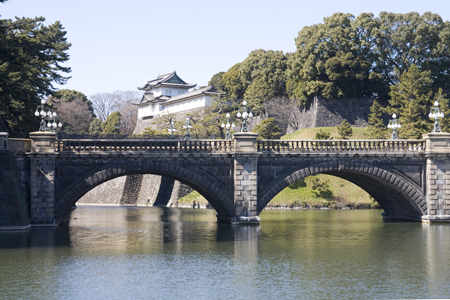
How to get there
- 5-minute walk from Nijubashimae station on the Chiyoda line
- 5-minute walk from Exit 2 of Hibiya subway station on the Mita line
- 8-minute walk from Exit B6 of Hibiya subway station on the Yurakucho line
Tokyo Station
The distinctive red brick architecture of Tokyo Station stands out against the glass and steel of the city. Originally built in 1914 and then rebuilt in 1947, the building has been given official status as a property of cultural importance and was finally restored to match its original appearance in 2012. Visitors can also stay at the popular hotel housed within the station building.
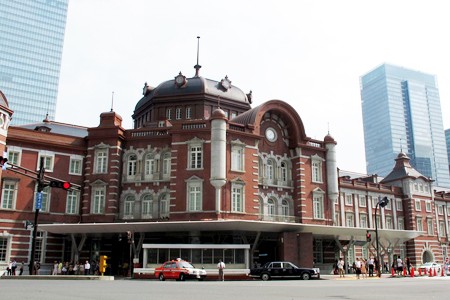
How to get there
- Tokyo Station can be reached via JR train lines and the Marunouchi line
Asakusa / Ryogoku
The City of Tokyo was originally known as Edo and the area of Asakusa and Ryogoku still retain that same historic atmosphere. Take a walk here and step back in time while visiting the many stores selling traditional items.
Sensoji Temple
Sensoji is the oldest and most impressive temple in all of Tokyo. Its main hall was built in the year 645 to house a miniature golden statue of Kannon, the goddess of mercy, which had been hauled up in a fishing net after being lost in the river some time before. This same statue ostensibly remains in the main hall today, though it is considered a sight too holy to be viewed by the masses. The present building is a reconstruction of the original, which was destroyed in the air raids of March 10, 1945 and the surrounding precincts bustle with people praying, buying o-mikuji papers bearing their fortune, shopping or sightseeing. Many others are drawn to the temple for the curative powers of the incense that burns in a giant bronze urn in front of the main hall. Such visitors can be seen rubbing the smoke on their joints in the hope of easing their aches and pains.
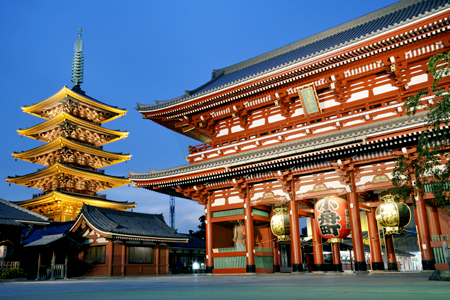
How to get there
- 5-minute walk from the North Exit of Asakusa station on the Tobu Isesaki line
- 8-minute walk from Exit 1 of Asakusa subway station on the Ginza line
- 10-minute walk from Exit 4/5 of Asakusa subway station on the Asakusa line
Nakamise Shopping Street
Nakamise is one of the oldest shopping streets in Japan and extends 250 meters from the front of Sensoji temple. It dates from the late 17th century, when local people were first granted the special right to open shops selling wares such as toys, sweets, snacks and souvenirs along the promenade to the temple. The original street was destroyed in the Great Kanto Earthquake of 1923 and again in the air raids of 1945. Rebuilt once again, the Nakamise of today still features shops selling traditional knick-knacks, rice crackers and festival food and retains the same blend of color, motion, and vitality as it did in the days of old Edo.
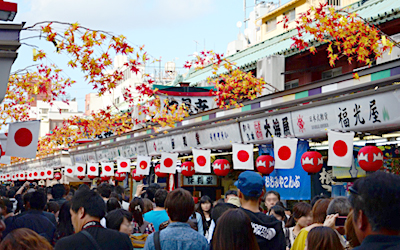
How to get there
- 5-minute walk from the North Exit of Asakusa station on the Tobu Isesaki line
- 8-minute walk from Exit 1 of Asakusa subway station on the Ginza line
- 10-minute walk from Exit 4/5 of Asakusa subway station on the Asakusa line
Tokyo Sky Tree
The height of the TOKYO SKYTREE was originally specified at approximately 610m in the original project. However, it was planned from the beginning to be the world's tallest free-standing broadcasting tower. After careful discussion and research on high-rise buildings that are being built around the world, it was finally decided on 634m, to become the tallest free-standing broadcasting tower in the world.
Thus, the 634m-high TOKYO SKYTREE was recognized by the Guinness World Records Company on November 17, 2011 as the tallest tower in the world.
TOKYO SKYTREE is designed in an original color, "SKYTREE White", representing harmony with the surrounding scenery, its name and the design concept: "The creation of city scenery transcending time: A fusion of traditional Japanese beauty and neo-futuristic design".
It was also designed to have the beauty of shades expressed in the form of an environmentally-friendly lighting system. Thus the plan adopted a design using all-LED lights to save energy, which also realized beauty at the same time.
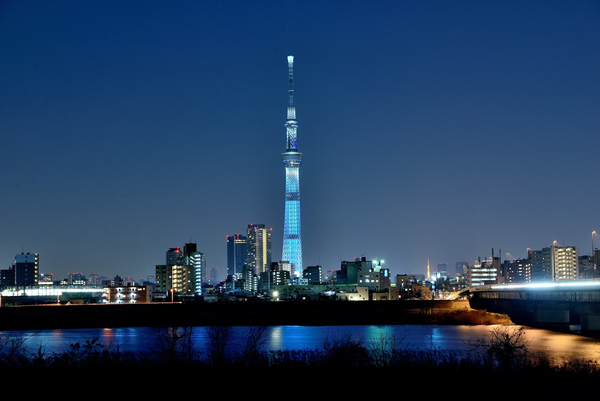
How to get there
- 15-minute walk from Asakusa Station on the Tokyo Metro Ginza line
- Short walk from TOKYO SKYTREE Station on the TOBU SKYTREE line
- Short walk from Oshiage Station(SKYTREE) on the Tokyo Metro Hanzomon line, Narita SKY ACCESS Keisei line and Toei Asakusa line
Edo-Tokyo Museum
Established in 1993, the Edo-Tokyo Museum takes visitors on a journey through time, using life-sized replicas and detailed scale models of sights such as the Kabuki Theater, Edo Castle and Nihonbashi Bridge to show how the 15th-century village of Edo grew to become one of the largest cities in the world. What's more, the museum is pleased to welcome international visitors with English-language explanations of exhibits, headsets and English-speaking tour guides. And as if the exhibits weren't enough, the museum itself is housed in a futuristic building that stands 62.2 meters tall—the same height as the tallest tower of Edo castle. With a total area of about 30,000 square meters, it's more than twice as spacious as the playing field of Tokyo Dome!
How to get there
- 3-minute walk from then West Exit of JR Ryogoku station
- 1-minute walk from Exit A4 of Ryogoku subway station on the Oedo line
Akihabara / Ueno
Akihabara
Akihabara is where you'll find bustling streets of specialty shops packed with the latest electrical appliances and pop culture items. Because it's an area that blends the old with the new, it's as pleasurable to walk around as it is to shop in.
Electric Town
The Akihabara electric town is a wonderland for electronics and computer buffs. Practically any appliance you can think of can be found on sale here, from hardware to software, to parts and second-hand goods. Many of these electronics goods can be bought for surprisingly reasonable prices. And even if the prices aren't so reasonable, Akihabara is a place where you can haggle and there are many shops that offer a duty-free service to make things even more affordable for foreign visitors.
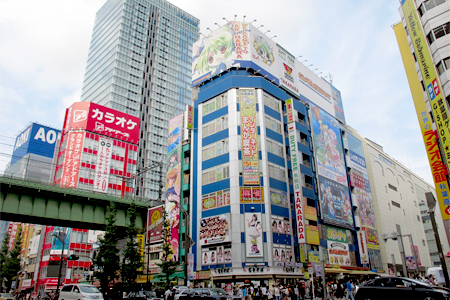
How to get there
- Short walk from the Electric City Exit of JR Akihabara station
- 5-minute walk from Exit 3 of Akihabara subway station on the Hibiya line
- 5-minute walk from Exit 1 or 2 of Suehirocho subway station on the Ginza line
Musical Instrument Area
If making music is your passion, you can find a fantastic range of shops selling musical instruments and sheet music on the street that runs from the West Exit of Ochanomizu station to Yasukuni station.
How to get there
- Short walk from the West Exit of JR Ochanomizu station
- 5-minute walk from Exit 2 of Ochanomizu subway station on the Marunouchi line
- 1-minute walk from Exit B1 of Shin-Ochanomizu subway station on the Chiyoda line
Ueno
Watch history and culture come to life in Ueno—a lively downtown spot that also features Ueno Park and a fascinating selection of museums.
Ameyoko
The streets leading from JR Ueno station to Okachimachi station are packed with stores offering clothes, miscellaneous goods, fresh fish and dried foods.
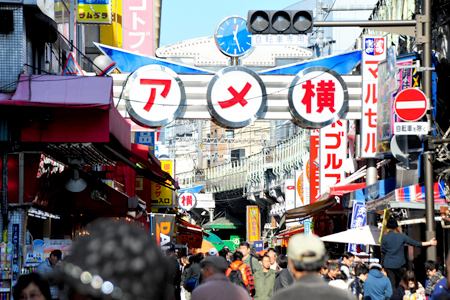
How to get there
- Short walk from the underground exit of JR Ueno/Okachimachi station or Keisei Ueno station on the Keisei line
- Ueno-Okachimachi subway station on the Oedo line
- Ueno-Hirokoji subway station on the Ginza line
Shinjuku / Shibuya
Shinjuku
Shinjuku is the vibrant, beating heart of the Tokyo metropolis. Its west side has towering skyscrapers, while its east side is one of the most crowded places in all of Tokyo. Shinjuku also has a south side with a scattering of tourist and entertainment spots just waiting for you to find them.
Tokyo Metropolitan Government Building
The cathedral-like Tokyo Metropolitan Government Building is a strong symbol of the Tokyo government. Designed by Japan's eminent postwar architect—Kenzo Tange—and completed in 1990, the building is Japan's fourth tallest at a breathtaking 296 meters. At the 33rd floor, the 48-storey building splits into two symmetrical towers and there are rapid elevators ready to whisk visitors up and away to the observation deck of each in just 55 seconds. Advanced technology also extends to the safety of the building, with special shock-absorbing pillars and posts specially designed to protect the structure in the event of an earthquake. There are so many reasons to visit the building, and here are just a few to get you started—the panoramic view is spectacular, Mt. Fuji and Yokohama are both visible on a clear day, and entrance to the building is completely free of charge!
How to get there
- Short walk from Exit A4 of Tochomae subway station on the Oedo line
- 10-minute walk from the West Exit of JR Shinjuku station
Kabukicho
Kabukicho is a unique entertainment district in Shinjuku, filled with interesting restaurants, movie theaters, games arcades and more.
How to get there
- 3-minute walk from Seibu Shinjuku station
- 5-minute walk from Exit B10-13 of Shinjuku subway station on the Marunouchi line
- 8-minute walk from the East Exit of JR Shinjuku station
- 10-minute walk from Shinjuku station on the Keio/Odakyu line
Shinjuku Gyoen National Garden
Originally created as a garden for the Royal Family in 1906, Shinjuku Gyoen National Garden is a national park that brings Japanese and European styles of gardening together in harmony.
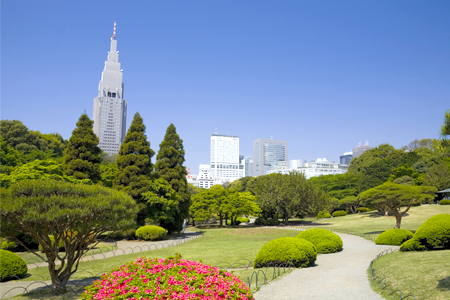
How to get there
- 5-minute walk from Shinjuku-Gyoenmae subway station on the Marunouchi line
- 5-minute walk from JR Sendagaya station
- 5-minute walk from Shinjuku 3-chome subway station on the Shinjuku line
- 5-minute walk from Kokuritsukyogijo subway station on the Oedo line
- 10-minute walk from the South Exit of JR Shinjuku station
Shibuya
A chic part of town where the latest trends are born, Shibuya continues to capture the interest and imagination of Japan's young generation.
Meiji Jingu Shrine
Meiji Jingu is a Shinto shrine dedicated to Emperor Meiji and his wife, Empress Shoken—the great-grandparents of Japan's current emperor—who passed away in 1912 and 1914, respectively. Built in 1920, the shrine comprises three areas: the inner precincts known as the Naien, which are centered on the shrine buildings; the outer precincts known as the Gaien, which include sports facilities and the Meiji Memorial Picture Gallery; and the Meiji Memorial Hall. The shrine sprawls across 700,000 square meters of forest land containing 120,000 trees representing 365 species that were donated by people from all over Japan. The shrine is so impressive, it's no surprise that sumo wrestlers come here to give a demonstration bout to commemorate their arrival at the high rank of Grand Champion. The shrine is so beautiful and serene, it also serves as a spiritual home for the Japanese.
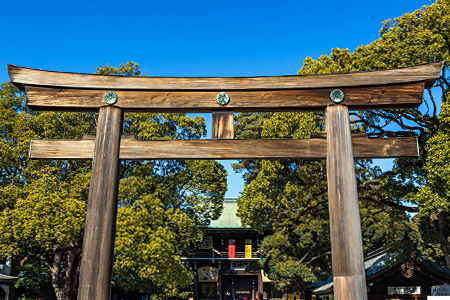
How to get there
- 1-minute walk from JR Harajuku station
- 1-minute walk from Exit 1 or 2 of Meijijingumae subway station on the Chiyoda line
- 5-minute walk from Odakyu Sangubashi station
Roppongi
A creative cultural and information center where you can feel the buzz of cosmopolitan Tokyo.
Tokyo Midtown
Tokyo Midtown is like a small city inside a single building, housing around 130 places of interest including fashion stores, restaurants, offices, and even a hotel.
How to get there
- Directly connected to Roppongi station on the Toei Oedo line
- Directly connected to Exit 8 of Roppongi station
- Via the Exit 4A underpass/3-minute walk from Exit 3 of Nogizaka station on the Chiyoda line
Roppongi Hills
A cultural mega-complex, Roppongi Hills boasts around 230 shops and restaurants, a multiplex cinema, residential apartments, a hotel, a TV station, an observatory, and even an art museum. You can also get one of the best bird's eye views of Tokyo from the open-air rooftop Sky Deck.
How to get there
- Exit 1C of Roppongi subway station on the Hibiya line
- 5-minute walk from Exit 3 of Roppongi subway station on the Oedo line
- 5-minute walk from Azabujuban Subway station on the Oedo line
- 8-minute walk from Exit 4 of Azabujuban subway station on the Namboku line
The National Art Center
A new concept in art spaces, the National Art Center has no collections of its own, but it does offer one of the largest exhibition spaces in the whole country (14,000 m2). However, this is more than just a space. Think of it instead as a place with incredible capacity to bring together people, share information, and promote learning—all in the name of art!
How to get there
- Exit 6 (directly connected to the center) of Nogizaka station on the Tokyo Metro Chiyoda line
- 5-minute walk from Exit 4a of Roppongi station on the Tokyo Metro Hibiya line
- 4-minute walk from Exit 7 of Roppongi station on the Toei Oedo subway line
Shiodome / Shiba / Takeshiba
The bay area provides a special vantage point from which you can take in the sights of modern Tokyo and traditional Edo at once. Take a cruise across the bay and begin your journey to even more shopping and dining destinations.
Tokyo Tower
At a height of 333 meters—a full 13 meters more than the Eiffel tower—Tokyo tower is the world's tallest self-supporting iron structure. Its uppermost observation deck offers a spectacular view of Ginza, Tokyo Bay, Yokohama, and Mt. Fuji and it was originally built as a broadcast tower in 1958. The tower still remains functional today as a relay tower for five FM radio stations and nine TV stations, while attracting visitors to its many attractions such as the aquarium on the first floor, the waxworks museum, and the mysterious zone of hologram technology on the third floor. Beautifully illuminated and visible from far away, the tower acts as a familiar landmark both day and night.
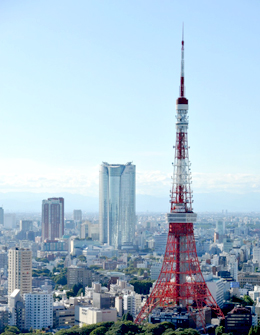
How to get there
- 5-minute walk from the Akabanebashi Exit of Akabanebashi subway station on the Oedo line
- 6-minute walk from Exit A1 of Onarimon subway station on the Mita line
- 7-minute walk from Exit 1 of Kamiyacho station on the Tokyo Metro Hibiya line
- 10-minute walk from Exit A6 of Daimon Subway station on the Asakusa line or Oedo line
Zojoji Temple
Founded in 1393 as a fundamental nembutsu seminary of the Jodoshu School in east Japan, Zojoji later became the family temple of the Tokugawa shogunate. The wooden gate of the temple remains as an original piece crafted in the early 17th century and has been designated as an important cultural property of Japan.
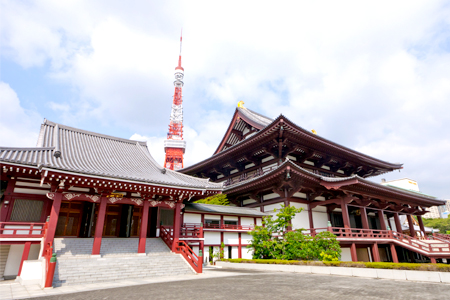
How to get there
- 3-minute walk from Exit A1 of Onarimon subway station on the Mita line
- 6-minute walk from Exit A6 of Daimon subway station on the Asakusa/Oedo line
- 10-minute walk from JR Hamamatsucho station
Water Bus
The water bus whisks you off across Tokyo bay, passing by a number of key spots along the banks of the Sumida river.
How to get there
- Hinode Office: 2-minute walk from Hinode station on the Yurikamome line
- 8-minute walk from the South Exit of JR Hamamatsucho station
- 10-minute walk from Exit B2 of the Daimon subway station on the Asakusa/Oedo line
Hamarikyu Gardens
These beautiful gardens were originally created for the Tokugawa Shogun family and are famous for the "Shioiri-no-ike" pond and two duck ponds within. These are the only remaining examples of tidewater ponds in Tokyo, with the Shioiri pond having been cleverly designed to achieve a landscape that transforms with the ebb and flow of the tide.
How to get there
- 7-minute walk from Tsukiji-shijo subway station or 5-minute walk from Shiodome Subway station on the Oedo line
- 5-minute walk from Shiodome station on the Yurikamome line
- 15-minute walk from JR Hamamatsu-cho station
- 12-minute walk from JR/Subway Shimbashi station on the Asakusa/Ginza line
- By Water-bus (from Asakusa to Hamarikyu)/Water line (Ryogoku – Hamarikyu)
Odaiba
One of the most breathtaking places from which to view the Tokyo bay, this waterfront complex offers all kinds of entertainment, a multitude of shopping opportunities, and an incredible range of dining options.
Rainbow Bridge
Cross the water to Odaiba and enjoy the view by taking the promenade of the 918 meter Rainbow suspension bridge.
How to get there
Access to the promenade entrance:
- Shibaura side/5-minute walk from Shibaura Futo station on the Yurikamome line
- Odaiba side/15-minutewalk from Odaiba Kaihin Koen station on the Yurikamome line
Fuji TV Headquarters
Enjoy an incredible 270-degree panorama of Tokyo bay from the 100 meter high spherical observatory of the Fuji TV headquarters and take home a souvenir or two from one of the shops inside.
How to get there
Access to the promenade entrance:
- 3-minute walk from Daiba station on the Yurikamome line
- 5-minute walk from Tokyo Teleport station on the Rinkai line










